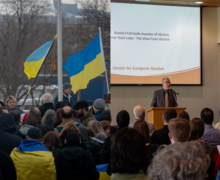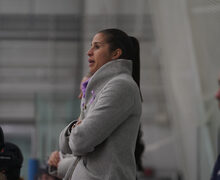From humble beginnings, University Union has persevered for 50 years to rise to the top
Courtesy of SU Archives
Forget what you know about University Union.
Forget the Block Parties. The Juice Jam shows. The Rock the Dome concert. Forget Kanye West and Ludacris and the rest of the constellation of stars UU has staged at Syracuse University. In 1962, UU was just looking for a home.
“We used to meet at the Chapel House, which was between Shaw and DellPlain,” said Steve Deckard, who served as UU chairman in 1966. “Or we’d meet in the Noble Room in the chapel. We did a number of concerts, which was fun, but our goal was to get a student center.”
So when Deckard visited the Schine Student Center after it was built in 1985, he didn’t just see the building he helped plan from the ground level. He saw years of disappointment, financial struggles, nomadic group meetings and sheer patience of will finally paying off.
“I’ve been in there a few times, and it’s everything I wanted it to be and more,” Deckard said.
This year celebrates UU’s half-century mark on campus, and pride is running high with the organization’s current members. Though the focus on securing a student union is now left to black-and-white press clippings and fond, fleeting memories, UU remains an integral part of SU’s campus.
“We’re working with Alumni Affairs on a few things,” said Lindsey Colegrove, current UU president. “We want the first part of our celebration to be an open house during Orange Central so students can come in and see everything we do.”
Times have changed since Deckard was a student. He remembers having to go on stage in the spring of 1967 to tell students that The Four Tops, whom UU had booked for a show, were nowhere to be found.
“I probably feared for my life a little bit,” he said and laughed.
It wouldn’t be the only time A-list acts would refuse to play at SU. In 1971, Gregg Allman of the Allman Brothers Band objected to a gig at Manley Field House since it still had dirt floors, according to the SU Archives. Bruce Springsteen, Billy Joel and Neil Young turned down concerts in 1979 because the Field House wouldn’t let them “fly” the sound, a process that would have involved rigging the sound system through the ceiling, according to the archives.
But eventually, UU’s concert programming became one of the organization’s calling cards. The first Block Party concert, now a MayFest staple, took place in 1989 and was headlined by Tommy Conwell and the Young Rumblers, according to the archives. Bonfires and riots at 1998’s Block Party caused the concert to be cancelled until it was reinstated in 2000, according to the archives.
Since then, Block Party has had more hits than misses. Rob Dekker, UU’s president during fall 2011 and spring 2012, said one of his proudest achievements was helping to bring rapper Drake to the Carrier Dome in 2010. It was the hip-hop artist’s biggest concert at that point in his career.
“It wasn’t long after that show that he just blew up,” Dekker said. “It was such a cool feeling to have him come to SU before that happened.”
Dekker is quick to defer credit, but the former president also played a pivotal role in adding a brand-new concert to SU’s arsenal: Rock the Dome, which featured Ludacris and Rick Ross for its maiden performance.
“As much as I’m proud of it, I wouldn’t have been able to do it without help from the previous presidents,” he said. “We all put a few years of planning into motion with it.”
Rock the Dome continued the tradition of UU, polling students on artists they’d like to see perform on campus. Deckard said that printing and handing out surveys during his time at UU was a big deal, although the polls have gone digital in more recent years.
UU’s concerts have grown bigger in scale since its inception, largely in part to establishing an annual budget at the tail end of 2010. Andrew Beyda, president of UU during fall 2010 and spring 2011, said that was an important part of programming bigger shows.
“It really allowed us to get talent before other schools could,” Beyda said. “It’s something we tried to do for a long time, and it was something we needed.”
It’s a far cry from the earlier days of what are now blockbuster concerts on campus. Adam Gorode, chairman of the first annual Juice Jam concert in 2004, recalls when the concert was a free affair hosted in the parking lot near Lawrinson Hall. Method Man, De La Soul and Phantom Planet drew a crowd of 3,000 students.
The show isn’t free anymore, but sells more tickets than ever. This year’s Juice Jam broke the concert’s ticket sales record with more than 7,000 students purchasing tickets to see disk jockey Calvin Harris and rapper Childish Gambino.
“It’s pretty cool that it’s been going on this long,” Gorode said. “It’s really been nine years? Man, I feel old.”
Gorode said being chairman of 2004’s Juice Jam was like having a full-time job. They modeled the show after an older campus tradition, what used to be a big outdoor festival on Lancaster Avenue.
“We’d spend weekends and nights in the office,” Gorode said. “People think it’s all the glory of meeting celebrities, but that’s not it at all.”
Even the concert’s name was borrowed. A 2003 concert called Juice Jam took place in Goldstein Auditorium, but Gorode and UU wanted to bring the music outside. However, Gorode still considered himself a bigger fan of the Bandersnatch Music Series, which showcases smaller musical acts.
He was thrilled when the event moved to a bigger space than the confines of a parking lot. The concerted moved to Skytop Field on South Campus for fear of the Quad being torn up by concertgoers.
“We have a tiny, tiny window of good weather in Syracuse,” Gorode said. “We decided to take advantage of it.”
But for alumni like Darren Goldberg, UU president during fall 2009 and spring 2010, the best part of putting on the concerts wasn’t meeting the acts he helped book or setting up behind the scenes.
“I’d love just walking around and getting to talk to students,” Goldberg said. “It was great to just hear how excited they were.”
Fifty years. Such a span of time holds many memories, but UU won’t spend too long waiting around on memory lane. Colegrove’s crystal ball for the organization’s future is still murky, but the broad strokes are starting to take shape. She hopes to get the ball rolling on adding larger-scale concerts and advance cinema screenings, among other goals.
Said Colegrove: “We’re looking for new ways to enhance programming, but we don’t know what it will be yet. It might not be this year or next one, but students will definitely see change.”
Published on September 5, 2012 at 2:30 am
Contact Erik: ervanrhe@syr.edu | @therealvandyman





